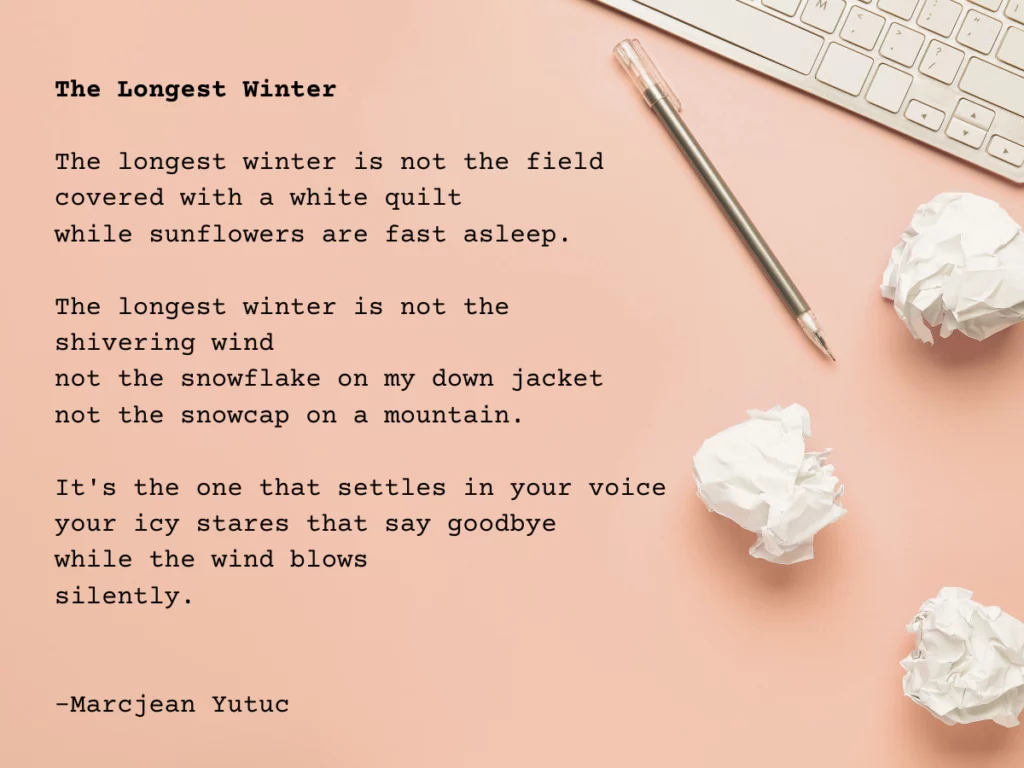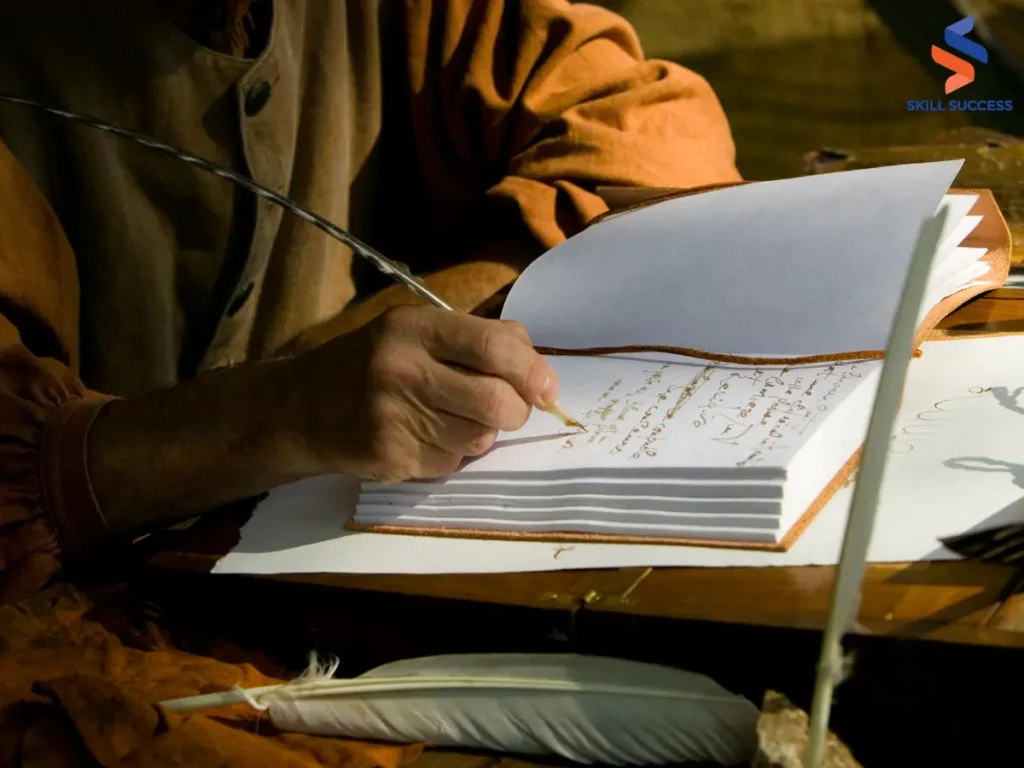Figurative language is a way of phrasing or wording that intentionally deviates from the literal meaning. In a sense, it aims to go beyond definition to become subject to interpretation. It's an essential part of creative writing, and it's also a valuable skill to have when learning languages.
Think of it as a boost that gives creative writing more meaning, depth, and feeling. If you look at figurative language in a poem or story, you will notice that figurative speech gives it more life and makes it more special.
Here are some of the most common examples of figurative language that you will find in poems:
Simile
A simile compares two things to each other with the use of the comparative words “like” and “as.” Expressions like “bright as the sun” and “run like the wind” are popular examples of Simile. Notice how Robert Burns uses Simile in this excerpt of A Red, Red Rose:
O my Luve is like a red, red rose
That’s newly sprung in June;
O my Luve is like the melody
That’s sweetly played in tune
In the first line, he compares his love to a red rose. On the third line, he does the same, comparing his love to the melody. Of course, it would not pass logic to liken a person to a flower or a song in its literal sense. However, symbolically, it evokes the poet’s adoration to his subject by comparing them to pleasant things.
Metaphor
A metaphor in a figurative language poem connotes one thing as another. Unlike Simile, it does not use “like” or “as” to compare two things. Take a look at this verse from Emily Dickinson’s Hope Is The Thing With Feathers to see it in action:
“Hope” is the thing with feathers
That perches in the soul
And sings the tune without the words
And never stops at all
If you noticed, she describes the word “hope” as one would a bird. You may also notice that there are no words that indicate comparison. Instead of saying that hope is like a bird, or that hope is like something with feathers, she directly describes it as a bird.
On top of that, you will notice that the lines following the metaphor continue to make bird-like descriptions. As a result, this figurative language poem is considered as an extended metaphor.
Jess Chua, an award-winning writer, says, “Figurative language adds style and creative flair through evocative, vivid imagery and effective word choices. They help elevate the meaning of the poem or sentence by helping the reader visualize or engage more deeply with the text”.
Here's an example and brief analysis through her poem, the fool, which appears in her debut chapbook: “Love is a red heart and a warning sign at the same time”
“I chose to use a metaphor as it was a concise and powerful way to describe the dichotomy, complexity, and intensity of falling in love. It also complemented the raw style of the chapbook that this poem was part of.”
Personification
Personification is imbuing human-like attributes to nonliving or nonhuman objects. J. Patrick Lewis’s Mister Sun is a great example of this.
Mister Sun wakes up at dawn,
Puts his golden slippers on,
Climbs the summer sky at noon,
Trading places with the moon.
You can see how Lewis describes the sun’s activity as one would describe a person’s activity throughout the day. In a logical sense, the sun does not wake up. It does not put on slippers, and so on and so forth.
However, in a figurative sense, the way he describes the sun’s activities is similar to how it rises in the morning, is high up in the sky at noon, and sets in the evening before the moon appears.

Here's a sample poem I wrote:
The longest winter is not the field
covered with a white quilt
while sunflowers are fast asleep.
The longest winter is not the
shivering wind
not the snowflake on my down jacket
not the snowcap on a mountain.
It's the one that settles in your voice
your icy stares that say goodbye
while the wind blows
silently.
The poem contains several examples of figurative language:
- Metaphor: The phrase "the longest winter" is a metaphorical way of describing a difficult or emotionally cold period in one's life.
- Metaphor: Describing the field as "covered with a white quilt" is a metaphor comparing the snow-covered field to a blanket.
- Personification: The line "sunflowers are fast asleep" personifies the sunflowers by suggesting they are sleeping as if they were living beings.
- Personification: The phrase "It's the one that settles in your voice" personifies the winter by suggesting that it can settle in someone's voice.
- Personification: Referring to "Your icy stares" personifies the stares by attributing the quality of being icy to them.
Hyperbole
A hyperbole is an exaggeration. It creates an effect that aims to magnify a point or emotion in a piece of writing. In everyday communication, you may hear phrases like “I could do this forever” or “that bag must have cost a fortune.” In a figurative language poem, it could appear like this:
Oh, I’m Dirty Dan, the world’s dirtiest man,
I have never taken a shower.
I can’t see my shirt—it’s so covered in dirt,
And my ears have enough to grow flowers.
Throughout the poem, it is quite apparent, especially if you look at the line where it says that his ears have enough dirt in them to grow flowers. Logically speaking, it is far from possible for a person to maintain enough dirt in their ears to grow flowers, but the hyperbole serves to convey just how dirty Dan is.
This poem by Shel Silverstein makes exaggerations to describe just how dirty Dirty Dan is. At the end of the poem, the reader gets a picture and a feel of just how filthy the character is by the exaggerations.
Understatement
If a hyperbole aims to exaggerate, an understatement does the exact opposite. It serves to downplay or undermine the significance or qualities of a situation. Saying things like “It’s just like an ant bite”, or “It’s just a scratch” when pertaining to a deep wound or a serious injury is a good example. Another would be this figurative language poem:
Some say the world will end in fire,
Some say in ice.
From what I’ve tasted of desire
I hold with those who favor fire.
But if it had to perish twice,
I think I know enough of hate
To say that for destruction ice
Is also great
And would suffice.
This poem, Ice and Fire by Robert Frost talks about the end of the world. However, he uses understatement to discuss it almost nonchalantly. It feels as if it was no big deal to choose between two options regarding the world’s destruction.

Irony
Irony happens when what is said directly contradicts what is meant. Exclaiming “Great!” or “how wonderful!” if your car broke down or if you spilled coffee on your white shirt is a strong everyday example of irony.
In a figurative language poem, it would look something like this line from Shakespeare’s Julius Caesar:
Mark Anthony:
But Brutus says he was ambitious;
And Brutus is an honourable man.
In these lines, Mark Anthony appears to praise Brutus after assassinating Julius Caesar. However, that is the complete opposite of what he meant in the situation. In a way, he is implying that he is neither ambitious nor honorable.
Did you know that you can get paid for creative writing? Follow the succeeding tips below to enchance your skills.

How to Use Figurative Language to Enhance Your Writing
Figurative language is not merely limited for use in poetry. However, it does help out a lot when it comes to creative writing. It also brings color, vibrancy, and emotion in your everyday writing. It is especially helpful when you feel like plain sentences can’t translate the intensity of the thought or feeling that you are trying to convey. Here’s how you can use figurative language to enhance your writing:
Use it sparingly
Too many figures of speech jammed into a sentence, or having a figure of speech for every sentence in a paragraph is not a good idea. Figures of speech are there to create an effect. Too much of it will not only lose its effect but also lose any meaning that your paragraph may have been trying to convey.
Make sure it fits
Choose your figurative language carefully. Not all figures of speech fit all types of statements, and not all statements merit a figure of speech. Make sure that it blends in naturally with your sentences while still creating impact and evoking emotion or thought.
Use it to describe or amplify
Sometimes describing something in plain wording is not enough. For example, instead of saying that “the field had so many flowers,” you may use figurative language and say that “the field looked like a vast ocean of a million blooms.” With the figurative expression, you can see in your mind’s eye just how plentiful the flowers are in the field.
Enhance your writing and productivity with Todoist, the ultimate task manager that helps you stay organized. Get started today and see how Todoist can transform your writing process.
Recommended Courses for Improving Figurative Language
1. Creative Writing For Beginners: Unlock Your Creativity

Creative Writing For Beginners: Unlock Your Creativity is an online course that unleashes your imagination and enhances storytelling skills. Perfect for beginners, it offers techniques, prompts, and tips to help you explore creative writing and unlock your creativity.
What sets this course apart is its comprehensive approach, covering various writing forms like short stories, poetry, and creative nonfiction. It offers practical techniques for character development and narrative crafting, making it accessible for anyone, even those with busy schedules.
I found this course inspiring and transformative. The lessons are engaging, with top tips from experienced writers that truly elevate your writing abilities. The supportive community of learners adds to the experience.
Who is this course for?
This course is ideal for beginners, busy individuals, and aspiring writers. If you want to enhance your communication skills, develop a consistent writing routine, and unlock your creative potential, this course is perfect for you. Enroll today and start your creative writing journey!
Take this course2. Write Now: The Video Series

Write Now: The Video Series is designed for anyone interested in learning the basics of writing, from discovering your unique voice to mastering the seven secrets of successful writing. This course offers practical advice through short, punchy videos that are perfect for both beginners and seasoned writers.
It focuses on essential writing skills like writing quickly, finding your voice, crafting dialogues, and understanding bad writing. It even provides a formula for writing a blockbuster novel, making it a comprehensive guide for aspiring authors.
This course is incredibly valuable and insightful. The videos are concise and packed with useful tips and tricks that can significantly improve your writing skills. The straightforward approach makes it easy to follow and implement.
Who is this course for?
This course is ideal for anyone from beginner writers to experienced authors. Whether you're just starting out, looking to self-publish, or seeking to enhance your writing craft, this course will provide you with the tools and knowledge to succeed. Enroll today and take your writing to the next level!
Take this course3. 10 Writing Exercises For The Modern Writer

10 Writing Exercises For The Modern Writer is a course designed to help you learn the basics of modern writing and practice daily writing exercises. It's perfect for those who want to improve their writing skills and overcome writer's block.
What makes this course unique is its focus on practical, powerful writing exercises that can be done daily. These exercises are designed to smash through writer's block and help you establish a consistent writing routine.
Personally, I found this course to be highly motivating and effective. The exercises are engaging and easy to follow, making it a great way to kickstart your writing practice.
Who is this course for?
This course is best for newbie or prospective writers who want to practice writing every day and struggle with writer's block. It's not suited for experienced writers who already have a daily writing routine or those looking for quick success. If you're passionate about writing and ready to put in the work, this course is perfect for you. Enroll today and start practicing with these fun and effective writing exercises!
Take this course
Key Takeaways
The beauty of poetry lies not only in its words but also in the artful use of figurative language that adds depth, emotion, and vivid imagery to the verses. From metaphors and similes that compare the known to the unknown, to personification that breathes life into the inanimate, and hyperbole that magnifies emotions, poets skillfully employ these tools to craft works that resonate with our hearts and minds.
To unleash the inner poet or playwright in you (or your students), try the Creative Writing for Beginners online course to teach you a couple of things about literary devices. It is the perfect online course that is beginner-friendly, so even if you have no literary experience whatsoever, you won’t find it too intimidating. However, if you already engage in creative writing and want to level up your skills, the Creative Writing Course: Master Tips for Writing could help you enhance your literary skills and make you a better creative writer.
If you want to unlock our entire library of courses, where you can explore subjects as diverse as art, music, business, health, and more, subscribe to our All Access Pass.
Join our community of learners and let the world of possibilities unfold before you. Start your journey now!
Editor's note: This post was originally published in October 2023. It has been updated for freshness and accuracy.

